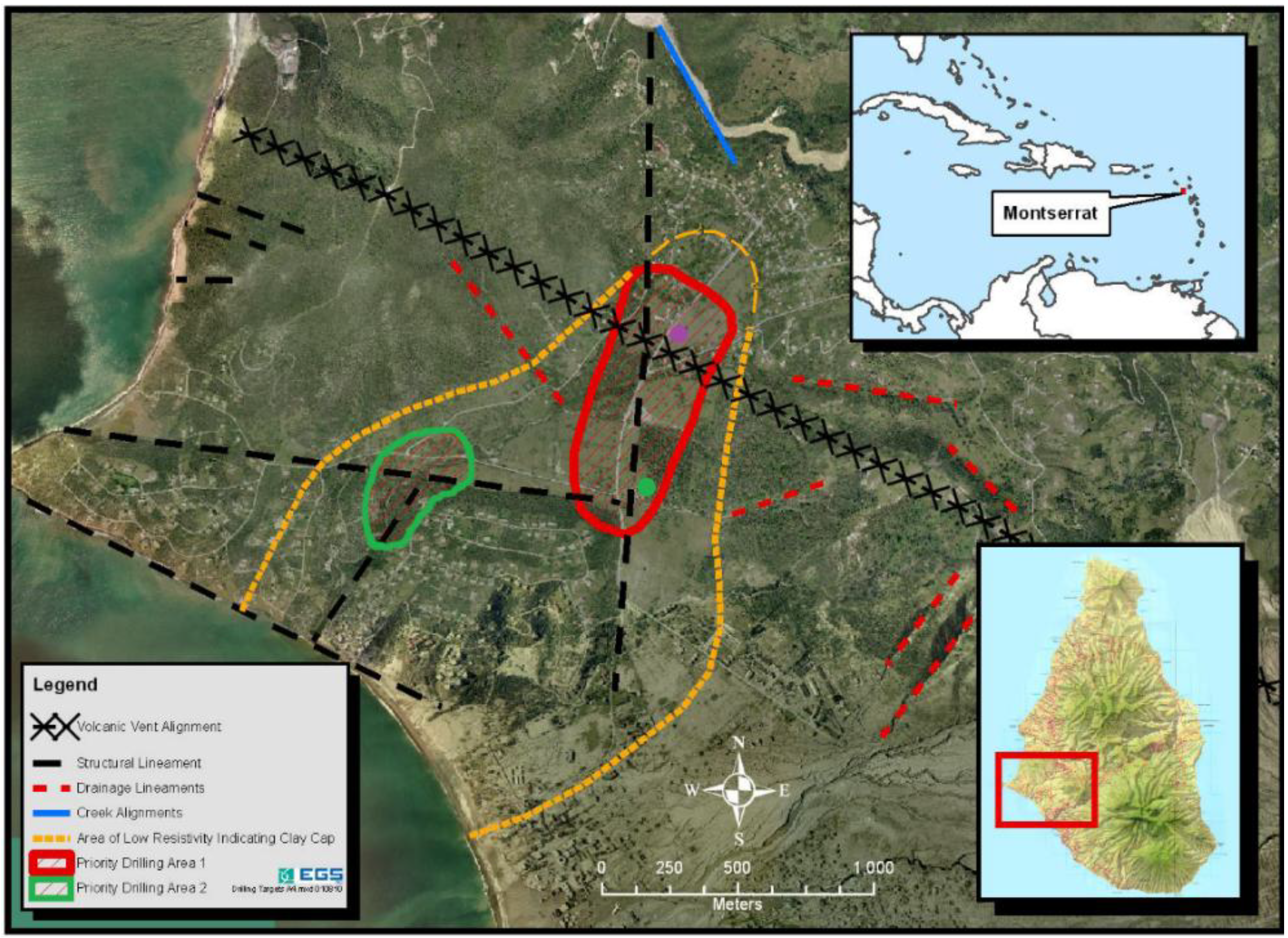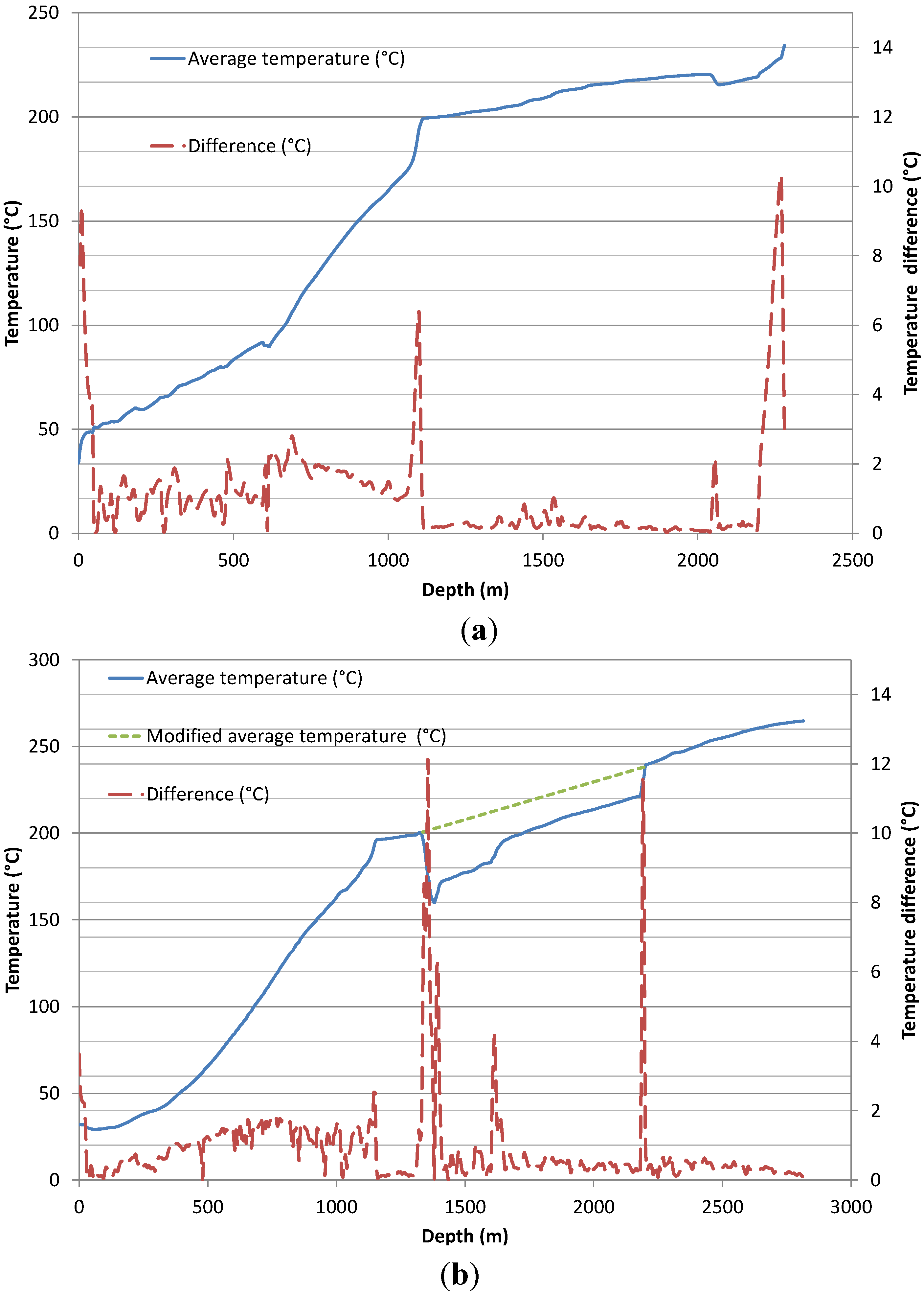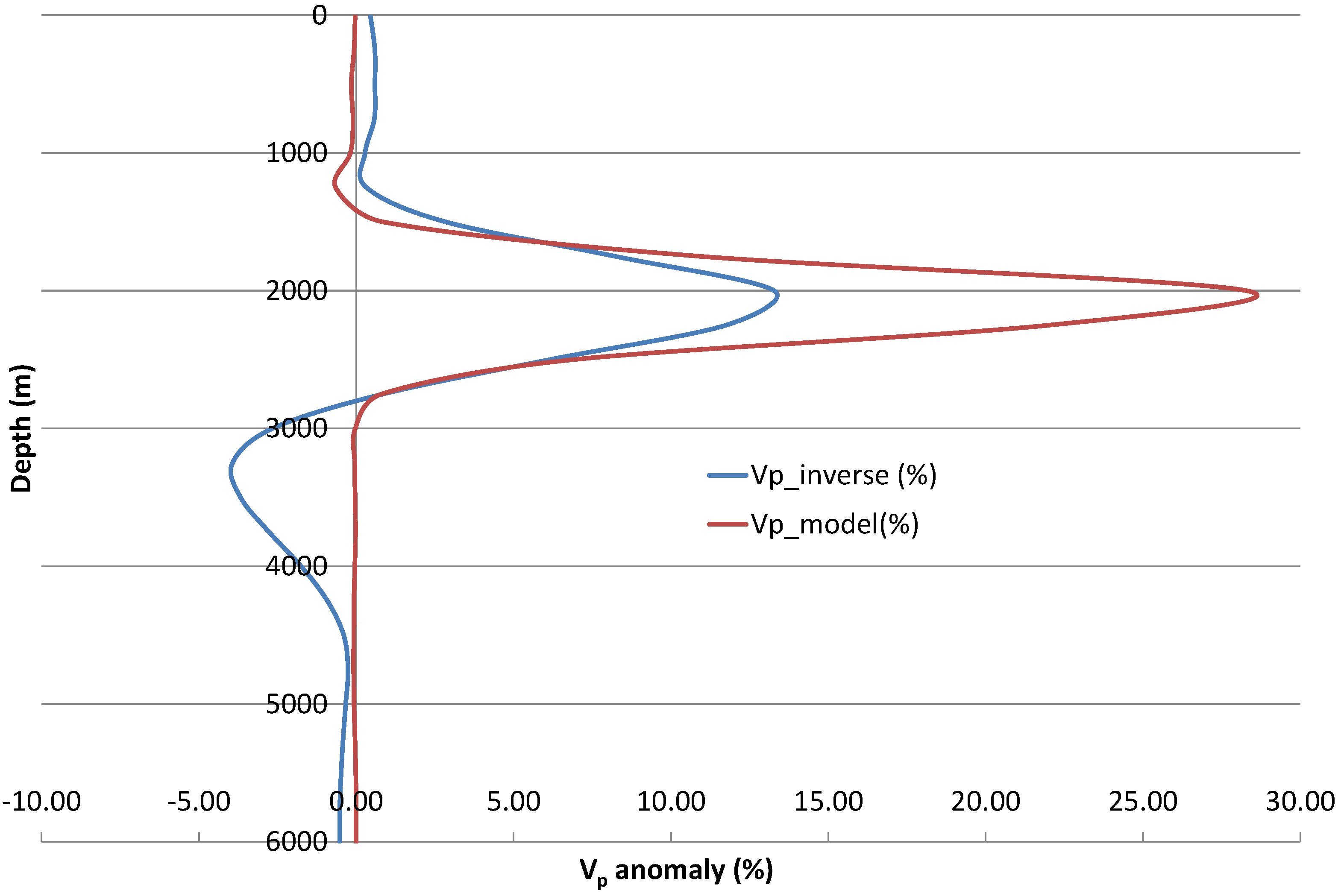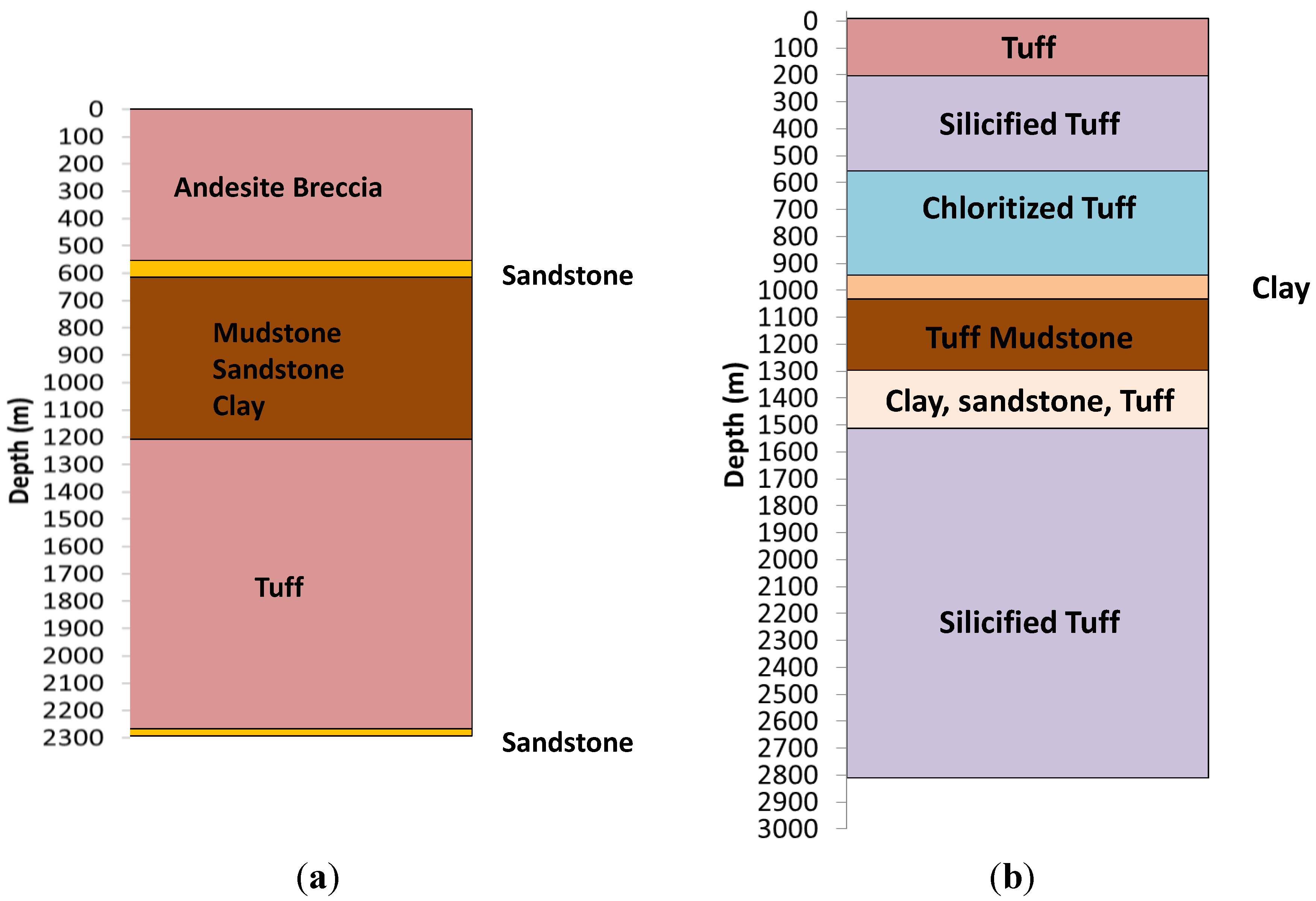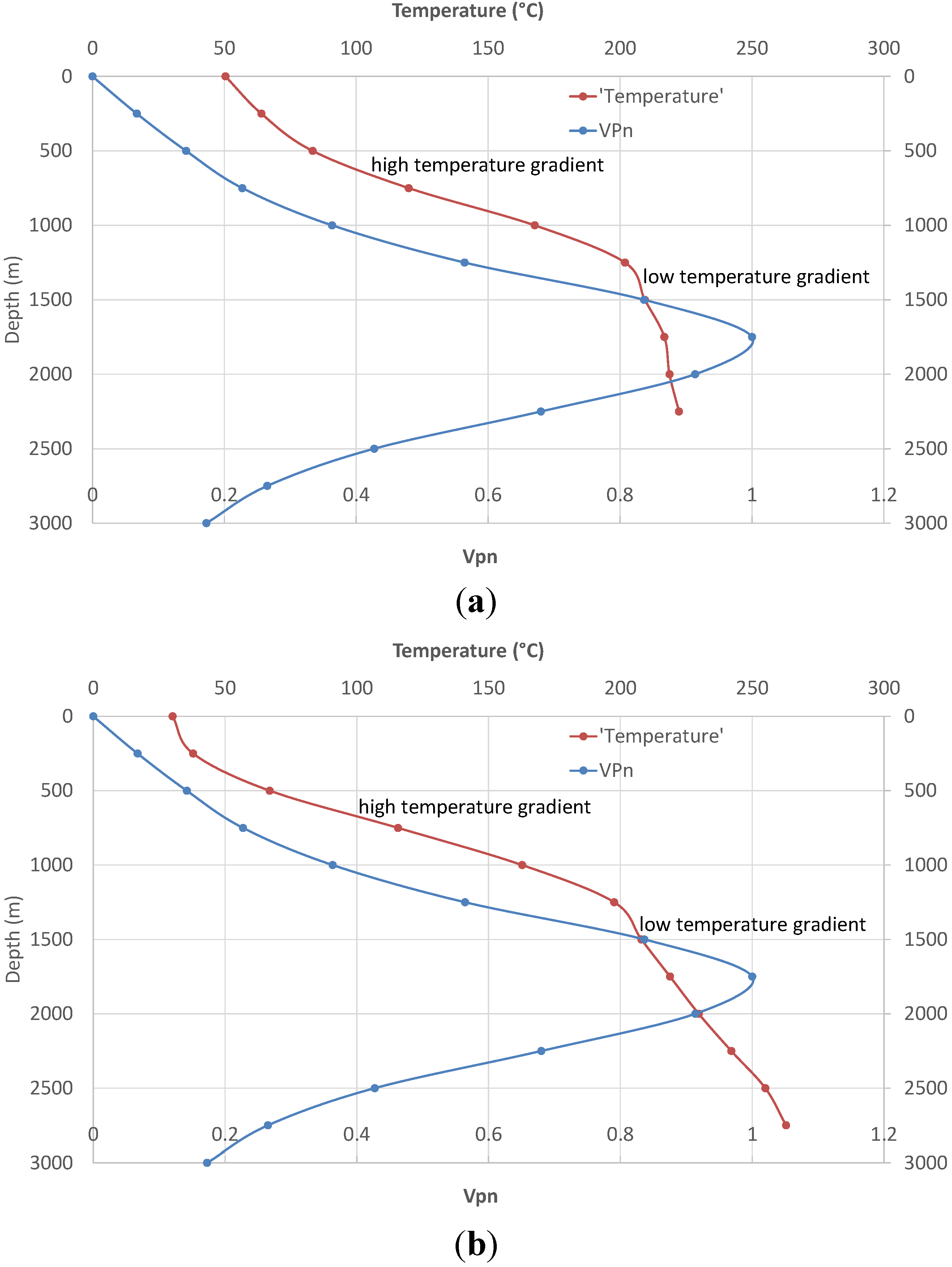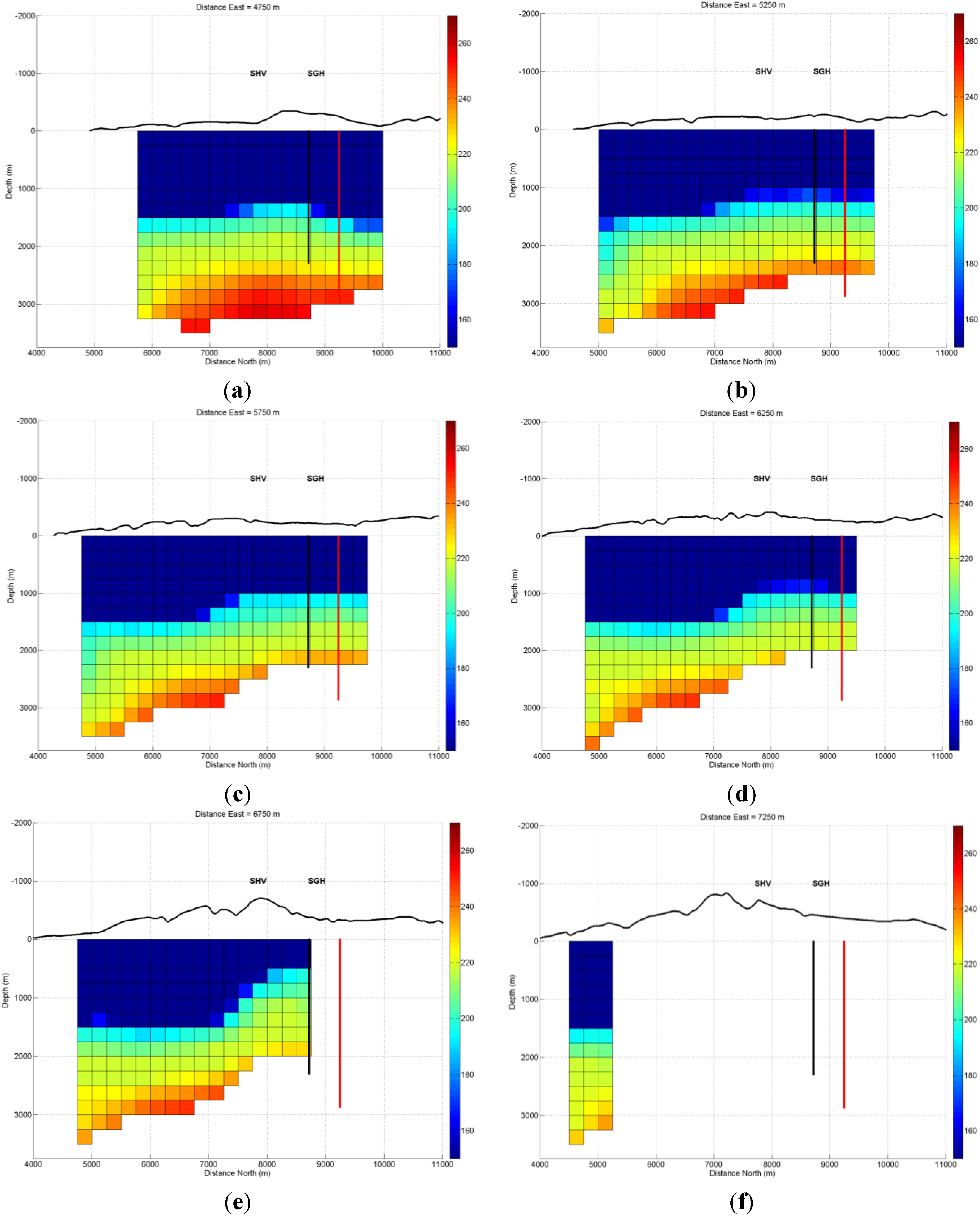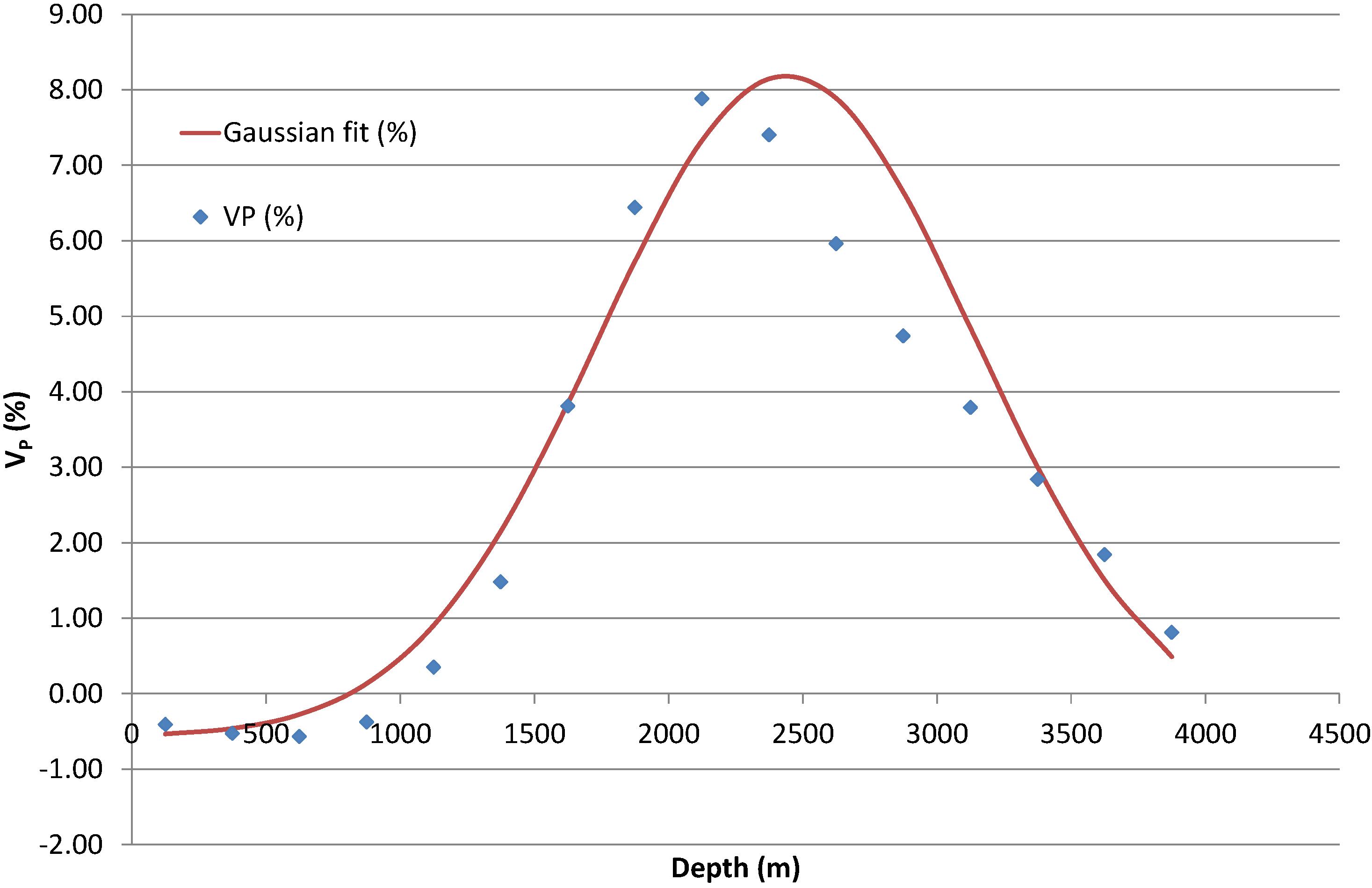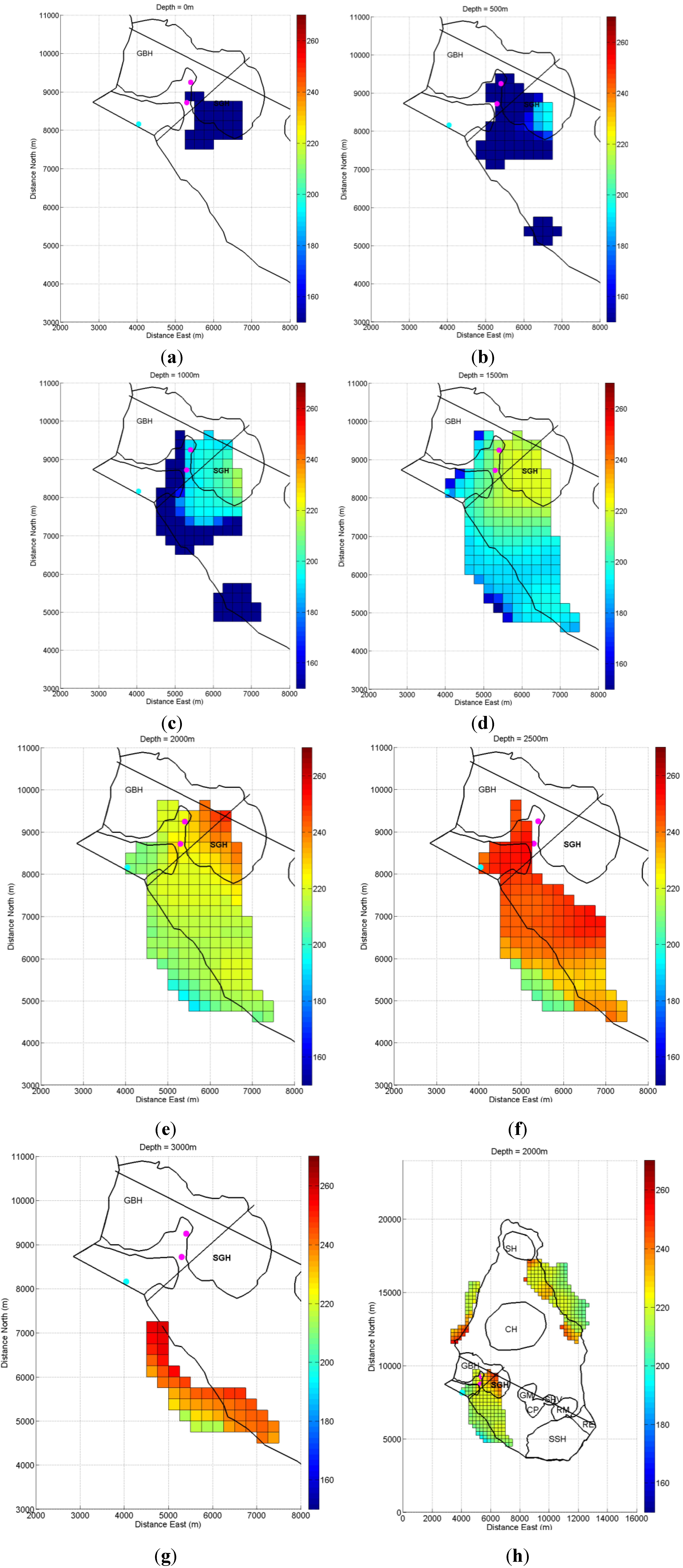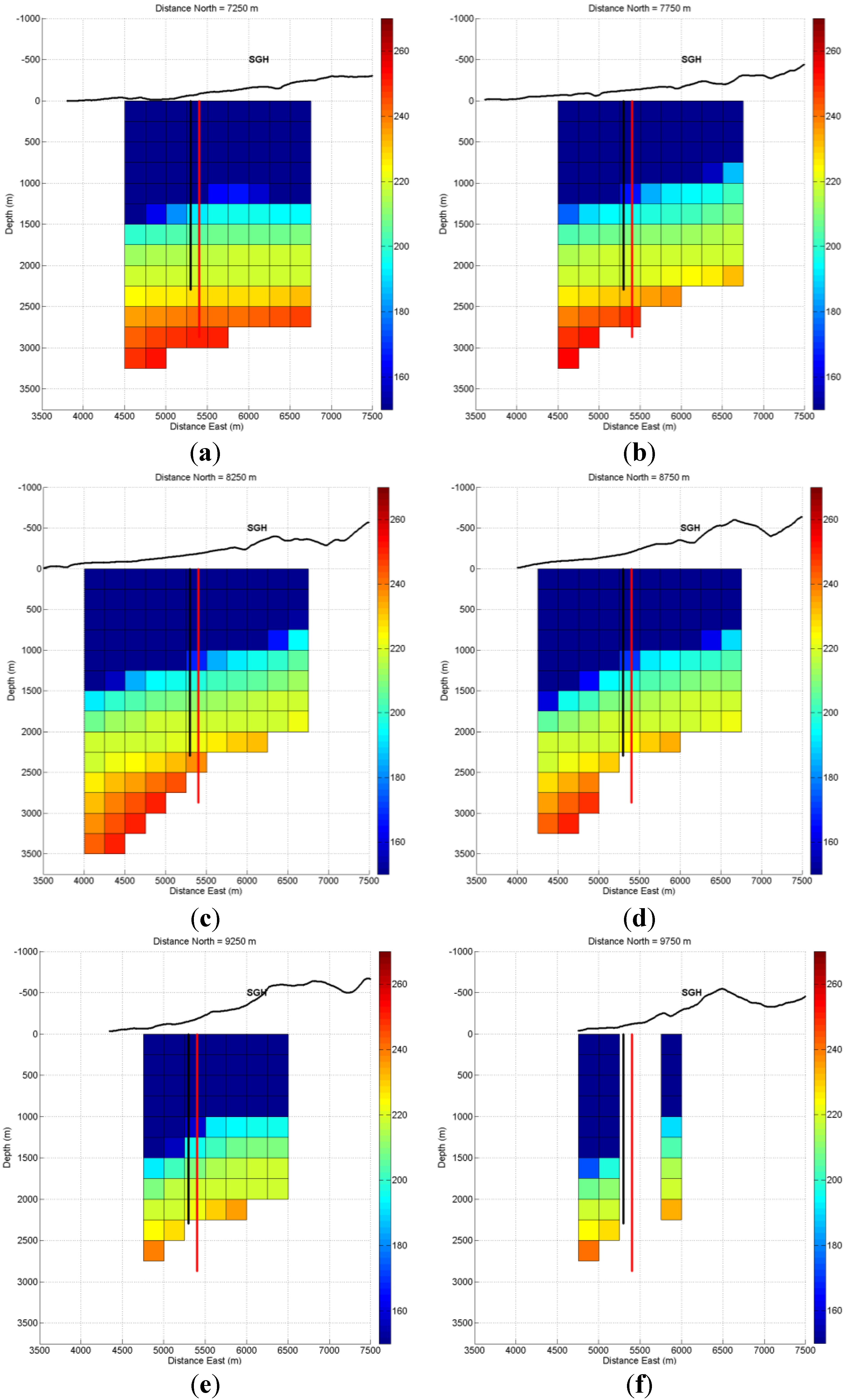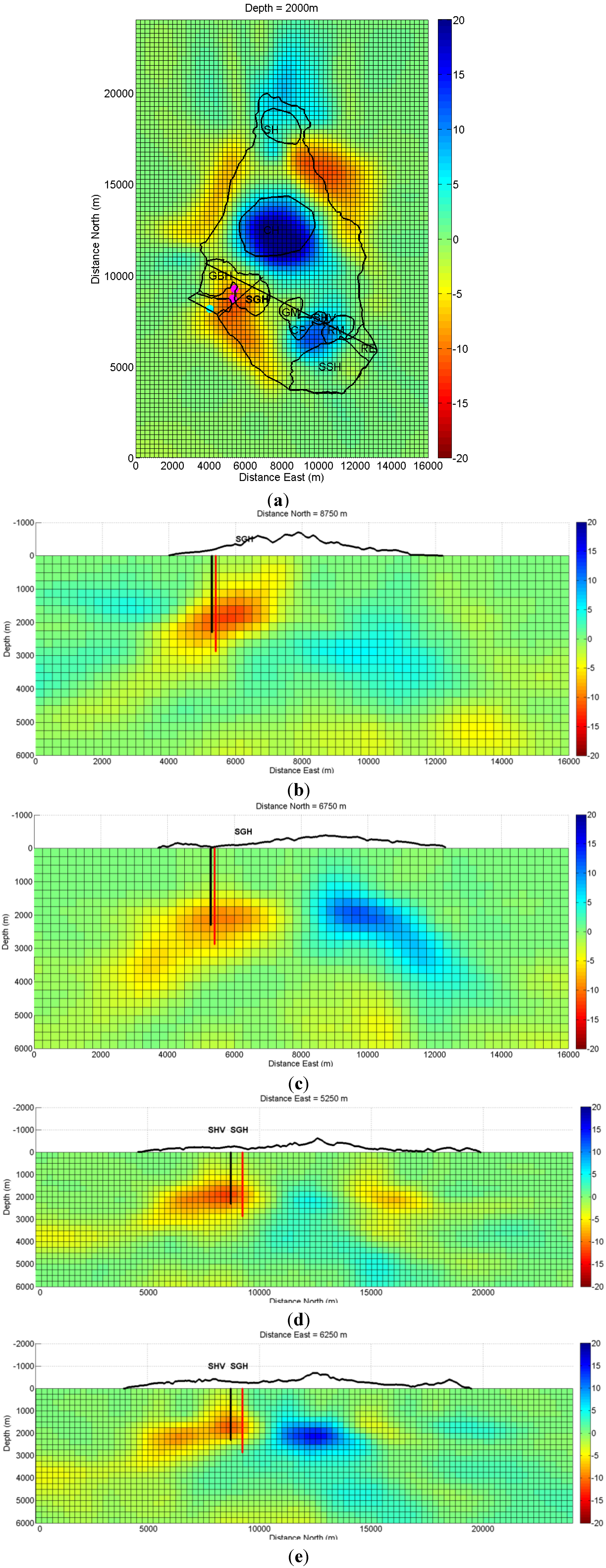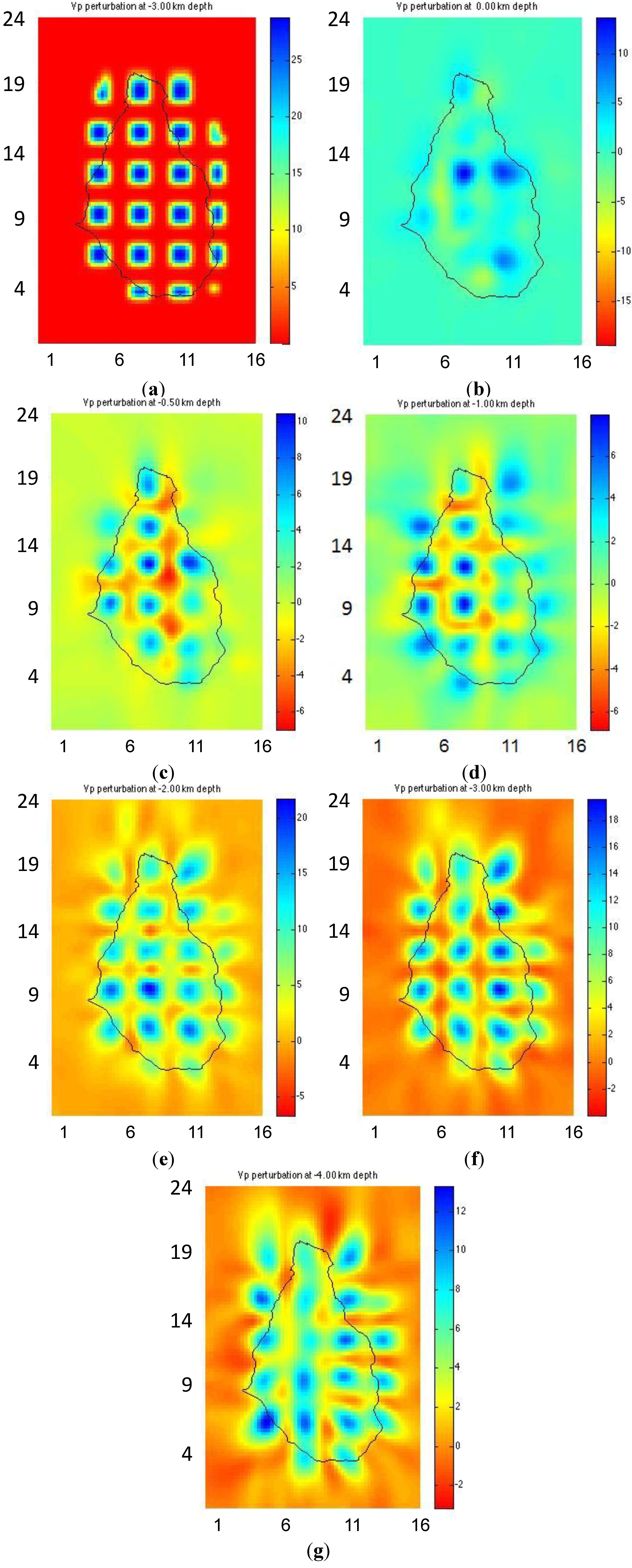3.1. Variations in Seismic Velocity with Depth and Temperature at Well-Locations
Extrapolating from the work of Kristinsdottir [
10], Ryan
et al. [
9] hypothesised that the magnitude of the seismic anomaly would be proportional to the reservoir temperature. The current study indicates that rather than a direct dependence on temperature, seismic velocity is likely mediated by temperature dependent variations in the hydrothermal mineral assemblage. The data show that while seismic velocity anomaly increases with temperature below 220 °C, above this temperature the relationship reverses in a way that was not anticipated by Ryan
et al. [
9].
Figure 6 shows the variation in measured temperature with normalized seismic velocity anomaly (
Vpn) as derived from the tomographic model of Shalev
et al. [
13] (
appendix). Tomographic data relating to the vertical series of model blocks which encompass the vertical well tracks for MON-1 and MON-2 have been used.
Vpn increases with temperature up to around 220 °C and then decreases with temperature.
Looking closely at the well temperature logging results shown in
Figure 6 we can see features in the data which support the general model of Ryan
et al. [
9].
There is a low temperature gradient between 1150 and 2800 m of about 50 °C/km. This low gradient is consistent with a high temperature convective upflow with a heat source below 2800 m depth and is unlikely to be associated with an outflow which would be associated with a temperature inversion at depth.
Between 1105 and 1150 m, there is a rapid increase from 50 to 190 °C/km in thermal gradient which indicates a switch from convective to conductive heat transfer. The rapid change in gradient indicates an impermeable barrier which impedes fluid flow across the depth at which the gradient change occurs. This impermeable barrier is consistent with the impermeable smectite clay cap observed in this depth range.
Figure 6.
Plot showing variation in well temperature and variation in normalized seismic velocity anomaly (
Vpn) with depth as derived from the tomographic model of Shalev
et al. [
13]. The
Vpn values used are the average value for wells MON-1 and MON-2. (
a) Values for well MON-1; (
b) Values for MON-2.
Figure 6.
Plot showing variation in well temperature and variation in normalized seismic velocity anomaly (
Vpn) with depth as derived from the tomographic model of Shalev
et al. [
13]. The
Vpn values used are the average value for wells MON-1 and MON-2. (
a) Values for well MON-1; (
b) Values for MON-2.
Seismic velocity variation across high temperature geothermal reservoirs has been observed at several locations [
23,
24,
25]. In most of these studies, seismic velocity inversion is performed on data sets consisting of natural seismic events. These data sets were generated by relatively small numbers of sources and receivers. It is also impossible to control source location and density. Models generated using passive seismic data therefore generally have limited resolution usually on the scale of kilometers; larger than the length scale of individual wells in the fields. This limited resolution makes detailed comparison between measured reservoir characteristics and seismic models impossible. In these studies, variations in seismic velocity are often ascribed to subsurface steam zones or highly saturated porous regions in the reservoir which would lower seismic velocity.
In some laboratory studies on reservoir rocks, the effects of the temperature of the saturating fluid and variations in porosity and clay concentration on measured seismic velocities were investigated [
11,
26]. These studies were limited in the spatial scale of the samples they could study and also in the timescale of the experiments which was (typically seconds to minutes). The temperature ranges were often limited as well. There were few measurements above 200 °C. Jaya
et al. [
26] explored variation in seismic velocity of highly porous (20%) liquid saturated samples. The results showed a significant decline in velocity as temperature increased. The results are explained in terms of a modified Gassman equation [
27]. Boitnott [
11] measured the seismic velocities of liquid saturated samples and used linear regression to determine the relative effects of porosity and clay concentrations. He found porosity to have the strongest effect on seismic velocity, with the concentration of illite having the second most significant effect. Seismic velocity was found to decrease with both increasing porosity and illite concentration.
Kiddle [
22] performed a series of experiments on rock samples from Montserrat collected from the surface and upper 200 m. Both dry andesite and andesite breccia samples show little velocity variation with temperature, samples were heated up to 600 °C. However, velocity was found to increase significantly with pressure. Pressure was increased up to 70 MPa. A large variation in seismic velocity was measured between the andesite and andesite breccia samples. P-wave velocities of 2.5–5.5 km·s
−1 were measured for solid andesite samples at room temperature and pressure whilst significantly lower values of 1.6–3.6 km·s
−1 where measured for andesite breccia samples under the same conditions. This variation is reflected in the seismic velocity anomaly model shown in
Figure A1. The dense andesite cores beneath the volcanic centers, particularly the Soufrière Hills and Centre hills, have high seismic velocities compared to the flanks which are composed largely of andesite breccia. Kiddle, however, does not address the significant variations in the velocities of the flank deposits.
The direct effect of temperature on seismic velocity seems to be an unlikely explanation for velocity variations observed in Montserrat as temperature increases monotonically with depth but the seismic velocity anomaly decreases at a depth of around 1750 m and a temperature of around 220 °C. Similarly, for porosity to be responsible for the observed pattern would require a steady increase in porosity to a depth of 1750 m after which porosity rapidly decreases. This again seems unlikely although Brophy
et al. [
8] do suggest there may be some stratigraphically controlled permeability/porosity at around 2100 m. The temperature pressure profile indicates that the reservoir fluid is in a liquid state as it does not cross the boiling point for depth curve.
The hypothesis that hydrothermal clay alteration may be responsible for the observed velocity anomaly is feasible since cutting logs show smectite clay alteration in the 600–1200 m depth range. In assessing the hydrogeology of Montserrat, Geotermica Italiana [
4] outlined the likely effects of hydrothermal alteration on reservoir rocks on the island and its effect on the mechanical properties of the rock. The effects of hydrothermal alteration at the water–rock interfaces give a possible explanation for the observed variations in seismic velocity.
At intermediate temperatures between 90 and 130 °C superficial alteration processes (weathering) are greatly enhanced and smectite clay is formed. Rather than being removed via erosional processes as it would be at the surface this swelling clay accumulates along preferential flow pathways reducing porosity to form an impermeable barrier. At the higher temperatures of 130–200 °C, phyllic alteration occurs with the formation of first interlayered illite-smectite and finally illite at temperatures above 200 °C. This process causes the rock to become more plastic [
4].
Between 200 and 300 °C, we have propylitic alteration in which minerals such as quartz, epidote and adularia are formed; as the proportion of these framework silicates increases the reservoir rocks become more rigid and crystalline. Whilst permeability in these rocks can be reduced by deposition of silica, this can be easily reversed by tectonic activity.
This sequence of alteration gives a possible explanation for the observed velocity anomaly. Formation of phylosillicate clays, in particular illite, acts to plasticise the rock and reduce seismic velocity (increase seismic velocity anomaly) up to a temperature of around 200 °C; above this temperature propylitic alteration progressively increases the rigidity of the rocks causing an increase in seismic velocity (decrease in seismic velocity anomaly). This pattern of hydrothermal alteration represents the commonly observed pattern of alteration observed in high-temperature geothermal systems hosted in andesite rocks [
28]. Similar patterns of hydrothermal alteration are reported in the geologically similar neighbouring island of Guadeloupe [
29,
30]. This pattern of alteration is also used to interpret the resistivity anomalies associated with high temperature geothermal systems [
15,
31]. Further detailed studies of the mineralogy of existing samples along with samples, including possible core, from future wells in Montserrat is required to verify the petrology.
One of the difficulties in trying to infer reservoir seismic properties from the laboratory results is that separate phenomena are likely convolved. Variations in fluid temperature change its contribution to the P-wave velocity. At the same time, the properties of the rock matrix vary with temperature as a function of changes in the equilibrium assemblage of hydrothermal minerals. Experiments of Jaya
et al. [
26] take place on much too short a timescale for equilibrium alteration to occur and the experiments of Boitnott [
11] which investigate the effect of variations in porosity and variations in the concentration of hydrothermal clays all take place at a single temperature.
Experiments conducted by Kiddle [
22] which investigate the effect of temperature and pressure on rock from Montserrat were conducted on dry rock samples from the surface and shallow subsurface and are not representative of saturated altered reservoir rocks. Experiments on saturated samples were also conducted but these were performed at room temperature and pressure. These experiments showed little effect of temperature on P-wave velocity but a large velocity variation was measured between andesite and andesite breccia with P-wave velocities for breccia being significantly lower. The high velocity zones seen in the velocity perturbation maps in the
appendix is clearly related to the dense andesite cores associated with the volcanic centers [
13,
22]. However, there is a significant variation in P-wave velocity in the flank deposits. We suggest that the flank deposits with the anomalously low velocities, particularly the anomaly in the southwest of the island which is co-located with a verified geothermal system, are associated with hydrothermal alteration.
The lateral variation in the P-wave velocity of the flank deposits coupled with the fact the seismic velocity anomalies peak at a depth of 1750 m or so (within the zone of potential phyllic alteration within the reservoir) rather than being anomalous from the surface to depth supports the hypothesis that the velocity variations are dominated by changes in the hydrothermal mineral assemblage.
3.2. Correlation between Seismic Anomaly and Temperature
Figure 7 suggests, as was postulated in Ryan
et al. [
9], that there is a robust correlation between reservoir temperature and seismic velocity. To test this hypothesis, we recast the data to explore the correlation between the two. For this analysis, we combine the data from wells MON-1 and MON-2 to obtain the maximum number of data points under the assumption that the wells, which are approximately 500 m apart, sample similar regions of the reservoir. This assumption is supported by the similarity between the temperature profiles and the normalized seismic velocity anomalies for both wells. The value of the percentage P-wave velocity perturbation is multiplied by −1 to create positive values for the seismic velocity anomaly.
Figure 7.
Correlation plot for normalised seismic velocity anomaly (Vpn) and reservoir temperature. Data for wells MON-1 and MON-2 are combined. Three different correlation regimes (R1a, R1b and R2) are suggested by the data. One point has been rejected as an outlier. This point which relates to the bottom of well MON-1 is thought to be slightly distorted.
Figure 7.
Correlation plot for normalised seismic velocity anomaly (Vpn) and reservoir temperature. Data for wells MON-1 and MON-2 are combined. Three different correlation regimes (R1a, R1b and R2) are suggested by the data. One point has been rejected as an outlier. This point which relates to the bottom of well MON-1 is thought to be slightly distorted.
To produce this correlation plot, the resolution of the temperature data was reduced to match the resolution of the resampled seismic velocity model. The temperatures were averaged over 250 m intervals. The data suggest three dominant regimes (
Vpn refers to normalised seismic velocity anomaly and
T refers to reservoir temperature in °C):
- (1)
A slow increase in seismic velocity anomaly with temperature between 29 and 192 °C characterized by the following Equation (2) which fits the data with an
R2 value of 0.95
- (2)
A rapid increase in seismic velocity anomaly with temperature between 192 and 219 °C characterized by Equation (3) which fits the data with an
R2 value of 0.90
- (3)
A rapid decrease in seismic velocity anomaly with temperature between 219 and 263 °C characterized by Equation (4) which fits the data with an
R2 value of 0.96
The decision to parameterize the correlation data in the way described above is purely empirical and is strictly only valid for the local area and for the specific set of tomographic inversion parameters used. The linear fits were chosen for their simplicity and because they provide a good fit to the data. The correlation could have been parameterized using different functions.
The observed correlation is between temperature data obtained from well logs and the magnitude of
Vpn obtained from inversion of active seismic data [
13]. As with all geophysical inversions, the inverse model here is non-unique [
32] as discussed in
Section 2.2. The exact form of the inverse model is dependent on the damping parameters used to stabilize the inversion. The values were chosen to maximize the structural information contained within the seismic data whilst minimizing the effects of errors inherent in the data which make it difficult to obtain a solution to the ill-conditioned inverse problem [
32].
The correlations between
Vpn and temperature we obtain are not solely a function of subsurface geology but also depend on the inversion parameters chosen. A related consequence of the inversion process is the tendency for geological anomalies to be “smeared out” which limits the ability of the inversion to resolve small anomalies. Checkerboard test results shown in the
appendix show that the resolving power of the data remains good down to a depth of 3 km. Structures at the sub-kilometer scale are resolvable at this depth in the region of the geothermal reservoir. The checkerboard test data (
appendix) also illustrates how the initial model is “distorted” by the inversion process. The intensity of the anomaly decreases and the anomaly spreads out in space. Whilst the intensity of the anomaly varies, its general shape, although blurred tends to be stable. For this reason, we use the normalised seismic velocity anomaly in our analysis to reduce the effect of the particular choice of damping parameters on the magnitude of velocity anomaly.
Our favoured interpretation of the variation in seismic velocity with temperature is that it is related to the assemblage of hydrothermal minerals at different temperatures with clays being formed between 70 and 220 °C which progressively plasticise the rock matrix and reduce bulk and shear moduli of the rock and thus reduce P-wave velocity. Above 220 °C propyllitic alteration occurs which increases the proportion of framework silicate minerals such as quartz, epidote and adularia. This change increases the rigidity of the rock and increases the elastic moduli, again increasing P-wave velocity.
Alternate explanations for the observed low velocity anomalies such as variations in lithology, porosity, fluid saturation and cementation are also possible. None of these alternatives, however, directly explain the variation of the anomaly with depth, in particular why it peaks at a depth of around 1750 m in the region of the two wells. Alternate explanations cannot be totally rejected without further investigation, particularly of the cuttings from the existing wells. Core from future wells would be particularly valuable in future studies.
3.3. Creating a 3-D Temperature Model
Having determined that a correlation between seismic velocity anomaly and temperature exists, the next step is to use this correlation to estimate the subsurface temperature field from the seismic tomographic data. Knowing how subsurface temperatures vary in 3D will shed light on subsurface fluid flow pathways that would be of interest in geothermal energy exploitation.
Assuming our hypothesis explaining the cause of seismic velocity variation is sufficiently correct, it would be straightforward to convert the seismic anomaly data to temperature estimates if they were uniquely known. As discussed in
Section 2.2, inversion of the seismic arrival data leads to “distortion” of the measured anomaly leading to variations in the shape and intensity of the modeled anomaly. If we consider the seismic anomaly data as being made up of a series of 1-D vertical columns through the model space the “distortion” will vary as we move from the edge of the anomaly to the center. In particular, the intensity of the anomaly will appear to decrease as it is “smeared out” at the edges. However, using the assumption that the maxima of the anomaly should be relatively undisturbed even if its absolute value varies and that the maximum is related to a unique process
i.e., a change in hydrothermal mineral assemblage which occurs at a fixed temperature in this geothermal reservoir we propose using the normalised seismic velocity anomaly (
Vpn) to “undistort” the seismic data in the region close to the wells.
The seismic velocity anomalies as measured at the locations of wells MON-1 and MON-2 which are 500 m apart have very similar, somewhat Gaussian, shapes and similar amplitudes (
Figure 3). If we look at 1-D anomalies as we move away from the well locations to the edges of the anomaly we see that the shape of the anomaly remains similar but the amplitude decreases (
Figure 8). We suggest compensating for this amplitude reduction in the region close to the wells, at which reservoir conditions are similar, by using
Vpn. We deem this a logical approach because conditions are similar in the region close to the measurement point, and the seismic velocity anomaly has a similar cause and shape. We postulate that the anomaly maximum occurs at a fixed temperature and is caused by a change in the regime of hydrothermal alteration. We therefore suggest that the maximum occurs at the same temperature in locations close to the well. Although this is not a fully rigorous approach, it has the benefit of simplicity and transparency. Our assumption, that nearby regions are similar, should be most robust closest to the zone where temperatures were measured and becomes less certain with distance from that location.
Figure 8.
Variation in seismic velocity anomaly as one moves from south to north near the location of well MON-1.The graphs relate to vertical columns through the seismic tomography perturbation model going from 5000 to 9500 m·N at 6000 m·E. Each block in the resampled model domain is a cube with side 250 m. The horizontal axis indicates the magnitude of the anomaly in %. Note also how the magnitude of the anomaly increases from the southern edge to a maximum and then decreases again.
Figure 8.
Variation in seismic velocity anomaly as one moves from south to north near the location of well MON-1.The graphs relate to vertical columns through the seismic tomography perturbation model going from 5000 to 9500 m·N at 6000 m·E. Each block in the resampled model domain is a cube with side 250 m. The horizontal axis indicates the magnitude of the anomaly in %. Note also how the magnitude of the anomaly increases from the southern edge to a maximum and then decreases again.
Figure 8 shows the variation in the seismic anomaly from the tomographic model going from south to north near well MON-1. This line correlates most closely to the N-S cross-section at 6250 m·E through the estimated temperature model in
Figure 9.
Figure 3 shows the bell-shaped anomaly seen in the tomographic model in the vicinity of the wells. The peak of this curve is associated in our interpretative framework with a change in hydrothermal mineral assemblage above 220 °C which causes an increase in the rigidity of the rock. An interesting feature of
Figure 8 is that we can see the peak of the curve indicating the change in hydrothermal mineral assemblage shallowing from south to north from about 2000 m depth to just under 1500 m. This shallowing is reflected in the estimated temperature model of
Figure 9 at 6250 m·E.
Figure 9 shows a shallowing of the high temperature region of the model at around 7500 m·N.
To complete this analysis efficiently we created a MATLAB
TM (Mathworks, Natick, MA, USA) script to automatically analyse the seismic anomaly model. The steps carried out by the script are outlined below:
- (1)
Create a master anomaly by averaging the anomalies at MON-1 and MON-2. Normalise this master anomaly.
- (2)
Use the master anomaly data and the averaged well temperature data to create three linear correlations between
Vpn and temperature as described in
Section 3.1.
- (3)
Loop over each vertical 1-D column in the seismic anomaly model volume.
- (4)
For each column, the anomaly is analysed to determine its similarity to the master anomaly’s roughly Gaussian shape. This is accomplished using a weighted least squares algorithm to fit an offset Gaussian function to the anomaly (
Appendix).
- (5)
RMS (Root Mean Square) value of the residuals between the best-fit Gaussian function and the seismic anomaly data is determined for each column of the seismic tomography model. If the RMS error is below 1/8th of the maximum value of the anomaly this is taken as a necessary but insufficient condition for similarity to the master anomaly.
Figure 10 shows the fit of seismic anomaly data to an offset Gaussian. A perfect fit is not necessary. The purpose of the fitting is simply to gauge general similarity of shape and to estimate the amplitude of the anomaly.
- (6)
If the amplitude of the seismic velocity anomaly is greater than 4% as well as having an acceptable RMS error the anomaly is deemed similar.
- (7)
All “similar” anomalies are “undistorted” by normalising them to vary between 0 and 1.
- (8)
The three correlations functions are used to derive temperature estimates from the “undistorted” anomaly. Care is taken to break each vertical anomaly into regions so that the region in which
Vpn increases with temperature is not confused with regions in which
Vpn decreases with temperature (see
Figure 7).
Figure 9,
Figure 11 and
Figure 12 show the results of the temperature estimation algorithm. Although the results of the estimation are, according to our theoretical framework, most justifiable at the areas closest to the wells the algorithm was allowed to operate over the entire seismic anomaly model domain. Results in regions far from the wells must be looked at skeptically.
Looking at the seismic velocity perturbation model (
Figure A1) we can see that temperature estimates have been made in the areas corresponding to the three regions in which there are slow seismic anomalies in the northwest, northeast and in the region of interest which is known to host a geothermal system, the southwest. The regions to the northwest and southwest cannot be interpreted with any degree of confidence since they are far from the wells that provide the correlating data. However, the analysis shows that the seismic anomalies in these three regions are similar to each other in the details of their structure.
Figure 9.
(a–f) N-S Cross-sections through the southwestern region of the temperature model estimated from the seismic velocity anomaly data. This region corresponds to seismic anomaly associated with the known geothermal system. Black line indicates the track of well MON-1 and the red line indicates the track of well MON-2. SHV (Soufrière Hills Volcano); SGH (St. George’s Hill). The colour scale indicates temperature in degrees Celsius.
Figure 9.
(a–f) N-S Cross-sections through the southwestern region of the temperature model estimated from the seismic velocity anomaly data. This region corresponds to seismic anomaly associated with the known geothermal system. Black line indicates the track of well MON-1 and the red line indicates the track of well MON-2. SHV (Soufrière Hills Volcano); SGH (St. George’s Hill). The colour scale indicates temperature in degrees Celsius.
Figure 10.
Fit of seismic anomaly data to an offset Gaussian function. The equation constants are Δ = −0.57,
k = 8.76, μ =10.26, σ = 3.95, the rms error is 0.80 (see
appendix for details). A perfect fit is not necessary. The purpose of the fitting is simply to gauge general similarity of shape and to estimate the amplitude of the anomaly. This anomaly was at location 4500 m·E and 8750 m·N in the model.
Figure 10.
Fit of seismic anomaly data to an offset Gaussian function. The equation constants are Δ = −0.57,
k = 8.76, μ =10.26, σ = 3.95, the rms error is 0.80 (see
appendix for details). A perfect fit is not necessary. The purpose of the fitting is simply to gauge general similarity of shape and to estimate the amplitude of the anomaly. This anomaly was at location 4500 m·E and 8750 m·N in the model.
The method described in this study presents the possibility of a method for estimating subsurface temperatures in a geothermal system with unprecedented resolution. Such a method would be of great use in geothermal exploration and well targeting. The interpretation framework described here requires further work to verify its validity but if it proves to be valid it would deliver another interpretation framework similar to the interpretation scheme used in interpreting resistivity anomalies in high temperature reservoirs [
33]. The areas of the model domain where no temperature estimates were made do not necessarily indicate low temperature. It simply means that the form of the seismic anomaly in these regions was dissimilar to that of the master anomaly and no interpretation was made.
Focusing on the southwest anomaly we see that the estimation algorithm makes testable predictions about the geothermal system. The model indicates that the regions of shallowest high temperature occur beneath St. George’s Hill. This is consistent with an upflow in this area. The zone of high shallow temperatures can be seen particularly well in
Figure 11 at the 1500 m depth. The shallowing of the high temperatures beneath St. George’s Hill is seen clearly in
Figure 9 in the 6250 m east cross-section.
This finding which indicates the existence of a geothermal system with an upflow beneath St. George’s Hill away from the Soufrière Hills volcano is supported by earthquake data and resistivity data described in Ryan
et al. [
9] and is consistent with early results from the well logging.
The temperature anomalies indicated to the NW and NE and seen in
Figure 11h are not corroborated by any evidence of active geothermal systems in these areas. However, no extensive studies have been carried out in these areas to date. A possible explanation for these zones is that they are related to zones of relict hydrothermal alteration which has modified the seismic velocities but is no longer related to a real temperature anomaly. This illustrates the constant necessity for multiple sources of information when interpreting geophysical data.
Figure 11.
(
a–
g) Planar views through the SW region of the temperature model estimated from the seismic velocity anomaly data. This region corresponds to the seismic anomaly associated with the known geothermal system; (
h) Planar view through the entire temperature model at a depth of 2000 m. Apparent temperature anomalies to the NW and NE may only be indicative of relict hydrothermal alteration in these locations or some other process altogether. The NW trending black line indicates a zone of structural weakness identified by Wadge and Isaacs [
34]. The NE trending black line indicates a fault plane identified from earthquake hypocenters beneath St. George’s Hill [
9]. The magenta dots relate to the locations of wells MON-1 and MON-2. The cyan dot relates to the location of the alkali-chloride hot spring at Hot Water pond. GBH (Garibaldi Hill); SGH (St. George’s Hill); GM (Gage’s Mountain); CP (Chances Peak); SHV (Soufrière Hills Volcano); RM (Roche’s Mountain); SSH (South Soufrière Hills); RE (Roche’s Estate); CH (center Hills); SH (Silver Hills). The colour scale indicates temperature in degrees Celsius.
Figure 11.
(
a–
g) Planar views through the SW region of the temperature model estimated from the seismic velocity anomaly data. This region corresponds to the seismic anomaly associated with the known geothermal system; (
h) Planar view through the entire temperature model at a depth of 2000 m. Apparent temperature anomalies to the NW and NE may only be indicative of relict hydrothermal alteration in these locations or some other process altogether. The NW trending black line indicates a zone of structural weakness identified by Wadge and Isaacs [
34]. The NE trending black line indicates a fault plane identified from earthquake hypocenters beneath St. George’s Hill [
9]. The magenta dots relate to the locations of wells MON-1 and MON-2. The cyan dot relates to the location of the alkali-chloride hot spring at Hot Water pond. GBH (Garibaldi Hill); SGH (St. George’s Hill); GM (Gage’s Mountain); CP (Chances Peak); SHV (Soufrière Hills Volcano); RM (Roche’s Mountain); SSH (South Soufrière Hills); RE (Roche’s Estate); CH (center Hills); SH (Silver Hills). The colour scale indicates temperature in degrees Celsius.
![Energies 07 06689 g011]()
Figure 12.
(a–f) E-W Cross-sections through the southwestern portion of the temperature model estimated from the seismic velocity anomaly data. This region corresponds to seismic anomaly associated with the known geothermal system. Black line indicates the track of well MON-1 and the red line indicates the track of well MON-2. SGH (St. George’s Hill). The colour scale indicates temperature in degrees Celsius.
Figure 12.
(a–f) E-W Cross-sections through the southwestern portion of the temperature model estimated from the seismic velocity anomaly data. This region corresponds to seismic anomaly associated with the known geothermal system. Black line indicates the track of well MON-1 and the red line indicates the track of well MON-2. SGH (St. George’s Hill). The colour scale indicates temperature in degrees Celsius.
